
Since it’s our beginning — and the start of a new year, too — what better way to greet 2014 than with the tales of some of your beginnings? As eyecare professionals, your successes and even your missteps are the stuff of great stories. Your ups, downs and lessons learned offer testament to business creativity and the power of entrepreneurship. What inspired you to get into this business? Was your business success clearly in the cards from the very start, or, like so many of our paths through life, more of a fortuitous accident? And since life is a process of continuous improvement and reinventions, how many of you have made new starts over your career? Like these five businesses we profile, however you got here … you’re here. Let’s celebrate new beginnings and the evolution of five great eyecare startups.
SO YOU’RE READY TO BEGIN?

Read Ravenously
 You have the eyecare know-how. Now it’s time to build your business knowledge. Start with Business Aspects of Optometry by Dr. John G. Classe (with others), then grab So You Want To Own the Store: Secrets To Running a Successful Retail Operation by Mort Brown and Thomas Tilling, which provides solid advice on all the basics: funding your startup, finding a location, negotiating a lease, hiring your first employees and more. Other good references for those challenging early days: The Bootstrapper’s Bible by Seth Godin and The Art of the Start by Guy Kawasaki. And, of course, keep reading INVISION and bookmark invisionmag.com.
You have the eyecare know-how. Now it’s time to build your business knowledge. Start with Business Aspects of Optometry by Dr. John G. Classe (with others), then grab So You Want To Own the Store: Secrets To Running a Successful Retail Operation by Mort Brown and Thomas Tilling, which provides solid advice on all the basics: funding your startup, finding a location, negotiating a lease, hiring your first employees and more. Other good references for those challenging early days: The Bootstrapper’s Bible by Seth Godin and The Art of the Start by Guy Kawasaki. And, of course, keep reading INVISION and bookmark invisionmag.com.
Be Ready to Work
 The comic definition of entrepreneur is “someone who works 80 hours a week for himself so he doesn’t have to work 40 hours a week for someone else.” That about sums it up. Help your business take off by always being in client acquisition mode. Be like the optician we saw on an industry discussion board who carries pliers in her purse at all times. — and who has been known to do repairs for clients in supermarket checkout lines.
The comic definition of entrepreneur is “someone who works 80 hours a week for himself so he doesn’t have to work 40 hours a week for someone else.” That about sums it up. Help your business take off by always being in client acquisition mode. Be like the optician we saw on an industry discussion board who carries pliers in her purse at all times. — and who has been known to do repairs for clients in supermarket checkout lines.
“Do your homework and be really organized,” adds Dr. Dori Carlson. (See page 62 to learn how the first female president of the American Optometric Association keeps her balance.) “This will alleviate so many headaches. Make no mistake, it will be a lot of work to get a practice up and running, but it will be worth it in the end.”
Advertisement
Love Your Work
 Are you just starting out and you aren’t sure how you will survive in an ever-more competitive market? “Do what you love,” says Nikki DiBacco of The Visionaries Group. “If you love what you do, whether it is pediatrics, ortho-K, glaucoma management, selling high-end luxury quality products or just being the best all-around eyecare professional you can be, your patients/customers will see that love, and it will reflect in referrals, word of mouth (priceless advertising!) and repeat business for years to come. I have seen this one simple concept — loving what you do — mean the difference in an office that outshines all the competition.”
Are you just starting out and you aren’t sure how you will survive in an ever-more competitive market? “Do what you love,” says Nikki DiBacco of The Visionaries Group. “If you love what you do, whether it is pediatrics, ortho-K, glaucoma management, selling high-end luxury quality products or just being the best all-around eyecare professional you can be, your patients/customers will see that love, and it will reflect in referrals, word of mouth (priceless advertising!) and repeat business for years to come. I have seen this one simple concept — loving what you do — mean the difference in an office that outshines all the competition.”
Tell The World
 Don’t spend so much on equipment and inventory that you have no money left to attract clients.
Don’t spend so much on equipment and inventory that you have no money left to attract clients.
Daniel Feldman of The Visionaries Group says eyecare professionals too often forget to ask themselves: “How are you going to get people into your exam chair, and back out the door with great looking eyewear? Did you put money aside for a great website? Did you put money aside for some local marketing? Did you put money aside for promotions? It’s amazing and at the same time heartbreaking how many new practices fail to budget for marketing and somehow assume people will line up outside their doors as if by magic.”
Experts suggest setting a marketing budget of 10 to 15 percent of your anticipated first-year sales.
Know Your Strengths
 “I recommend doing a SWOT (strengths-weaknesses-opportunities-threats) analysis to identify your strengths, and play to them. For us, our strengths are quality of care, relationships and community involvement,” says Dr. John Dovie, owner of Blacksburg Eye Associates in Virginia. “There are three options for providing care and products to our patients, but you can only pick two, you can’t have them all: quality, service, low price. I’d rather focus on the first two.”
“I recommend doing a SWOT (strengths-weaknesses-opportunities-threats) analysis to identify your strengths, and play to them. For us, our strengths are quality of care, relationships and community involvement,” says Dr. John Dovie, owner of Blacksburg Eye Associates in Virginia. “There are three options for providing care and products to our patients, but you can only pick two, you can’t have them all: quality, service, low price. I’d rather focus on the first two.”
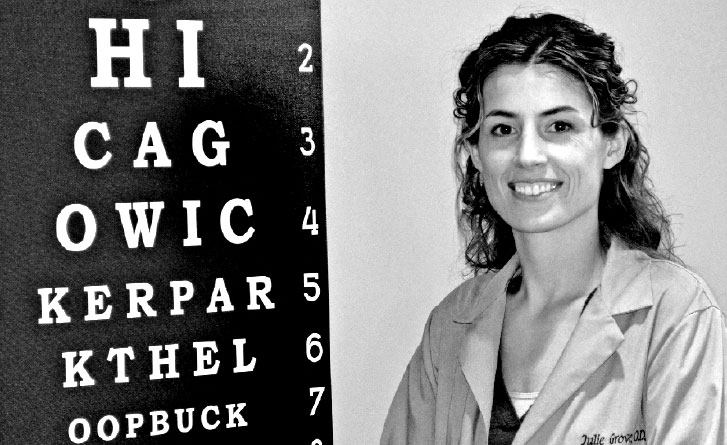
Advertisement
21 NORTH EYECARE
Location: Valparaiso, IN / Owner: Dr. Julie Grove / Founded: 2013 / Number of employees: 3 /
Specialty: Ocular Disease / Story by Julie Fanselow
It’s a little past 5 p.m. and Dr. Julie Grove has seen her last patient for the day. She checks in with her staff: optical manager Amber Travis and Juanita Stryzinski, who manages the front desk. They say their good nights, and Grove heads home — upstairs to the apartment above her practice, where her husband, David, and their not-quite-2-year-old daughter, Emily, welcome her.
Talk about an easy commute.
If there’s a common refrain among everyone we interviewed for this story, it’s that owning your own business is the key to professional autonomy and striking a balance between work and the rest of your life. But Grove takes that a step further as a rare eyecare professional who actually gets to work from home, or close to it — a welcome change from her previous 100-mile, two-hour roundtrip drive to Chicago. She opened her practice at 21 N. Washington St. in downtown Valparaiso, IN, just last July, and she says it’s already near the break-even point.
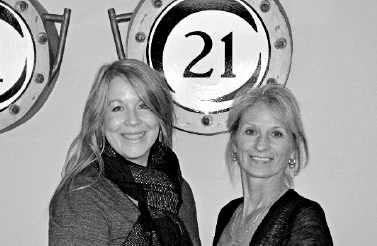
Optical manager Amber Travis and front desk manager Juanita Stryzinski of 21 North Eyecare
Living above her office is part of a grand plan Grove put in motion in February 2012 when she and her husband bought the old building that once housed what she recalls was “a seedy old townie bar called the Cuckoo Club.” Grove’s father, a contractor, worked first to complete the 1,600-square-foot apartment upstairs for Julie, David and their newborn daughter. Then came the downstairs makeover — “a total gut job” to transform the former tavern into a modern eyecare practice, also 1,600 square feet. The optical dispensary is up front, with Grove’s practice behind it. There’s still room left for a future fabricating lab.
Advertisement
While the renovations were under way, Grove continued driving to Chicago five days a week to work at the Illinois Eye Institute. (She still serves as a clinical instructor for fourth-year optometry student externs there every Monday.) But even after she’d gone part-time at the Eye Institute and opened 21 North Eyecare, Grove made extra money for her new business with fill-in work at two Veterans Affairs clinics.
WHAT I’VE LEARNED
- Making a lot of money isn’t everything — and it’s not a given in today’s competitive eyecare environment — “so just make sure you’re getting into it for the right reasons.”
- Working close to home is great.
- Pick your market. “I couldn’t and I didn’t want to compete with the local chains.”
- The business’ name was pure serendipity; Grove had no idea that starting with a numeral would land 21 North Eyecare atop local business directory listings, but that’s what happened.
VA clinic work was nothing new for Grove; after graduation from Butler University and the Illinois College of Optometry, she did a residency in ocular disease at the Boston Veterans Affairs Hospital. Although she was well schooled in medically based optometry, Grove had much to learn about owning a business, especially the optical dispensary side. “I had no retail experience,” she says, and she felt “completely in the dark” on how to identify the right product mix.
That knowledge gap was answered perfectly by hiring Travis, who is ABO-certified and had managed in both a corporate optical setting and an ophthalmology practice. “It was great to find someone who knows both sides,” Grove says.
The optometrist-entrepreneur has seen the sheer volume of work involved in launching an eyecare business. She puts in long days, and days off are rare. “I find myself needing a lot of time to handle administrative responsibilities,” she says. “The plus is, I can do it on my own terms.” Although 21 North Eyecare’s monthly revenue will soon match expenses, Grove says she’ll reinvest early profits in the business before she starts paying herself.
Grove suggests a gut check for anyone interested in starting her own business. In today’s constantly changing environment of managed care and industry consolidation, “Understand it’ll take a lot of work,” she says. “But even though I’m in the midst of the hardest time, I’m still enjoying it. I’m having fun and I like what we get to do.”

ORINDA OPTOMETRY GROUP
Location: Orinda, CA / Owners: Drs. Kristine Eng, Kelly Shintani and Jeffrey Lewis / Founded: 1985 / Number of employees: 9 /
Specialty: Primary Vision Care / Story by Corrie Pelc
You could say Dr. Kristine Eng was born to be an optometrist.
Both her father, Dr. Weylin Eng, and grandfather, Dr. Raymond Eng, were eye doctors, which meant Eng was exposed to the profession at an unusually young age. Eng’s first job? Where else but her father’s office — as a seventh-grader.
The seeds of the Eng family’s destiny in the optometry business were planted when Raymond Eng opened a practice about 75 years ago in Oakland, CA. His son Weylin grew the business with locations in nearby Orinda and El Sobrante. If there was any doubt that Kristine Eng would continue to nurture the family business, it vanished when she bought the El Sobrante practice just a year after graduating from UC Berkeley School of Optometry in 1998.
By 2003, Eng had a big choice to make, and also the opportunity for yet another beginning. Her father was nearing retirement and offered to sell her his Orinda practice. While she was satisfied with her work in El Sobrante, the opportunity for growth was too great to pass up. Thus, father and daughter embarked on a careful transition process, helping his patients get used to having Kristine Eng as their new doctor as she worked in both practices.
WHAT I’VE LEARNED
- Feeling overwhelmed? Remember that you’re getting a great education! While managing two practices for several years was intense, Eng got a crash course in the essentials of running a successful practice.
- Give back to your community. It’s an Eng family tradition.
- Hire expert help. Eng brought in a consulting group in 2004 to update the Orinda practice. They installed an electronic health records system and remodeled the office, doubling its size.
In 2006, Eng brought on Dr. Kelly Shintani, who became a co-owner of the practice with her in 2008. Following the full retirement of Eng’s father, Eng and Shintani invited Dr. Jeffrey Lewis to merge his existing practice with theirs. “It’s worked out really well, now that my dad’s retired, to have a male in the office,” Eng says. “I’m very fortunate we all work very well together.”
Having a full team in the office means the doctors can have a life outside work. “My children are in preschool and in first grade, and I can still spend time with them and my husband,” says Eng, who also volunteers in her kids’ classrooms and raises money for breast cancer awareness.
Eng says Orinda Optometry Group has grown every year, and now generates profits four times larger than three decades ago. The doctors want to expand hours and offer new services. Still, the group knows its strength: It’s a medically-oriented practice where doctors and staff educate patients to see them first with any eye problems.
That medical emphasis doesn’t mean that eyewear sales are an afterthought. Far from it. One of Eng’s father’s lasting legacies in the business was his ability to make multiple eyewear recommendations to patients tailored to their lifestyles. “To this day, I have patients that tell me ‘Your dad prescribed for me these knitting glasses’,” Eng says. “He would have multiple prescriptions for them and I think the patients really liked that he was getting to know them and also taking care of their visual needs.”
Eng’s story shows that most eyecare pros’ careers are a series of beginnings — and how recognizing new opportunities can help move any business forward. She advises others who seek to start or expand their own business to embrace change and begin pursuing their goals. “It’s better to do it sooner so you can enjoy it,” Eng says. “You can’t be worried or scared ‘what if it doesn’t work?’ As long as it’s calculated, it’s worth all the time and investment.”
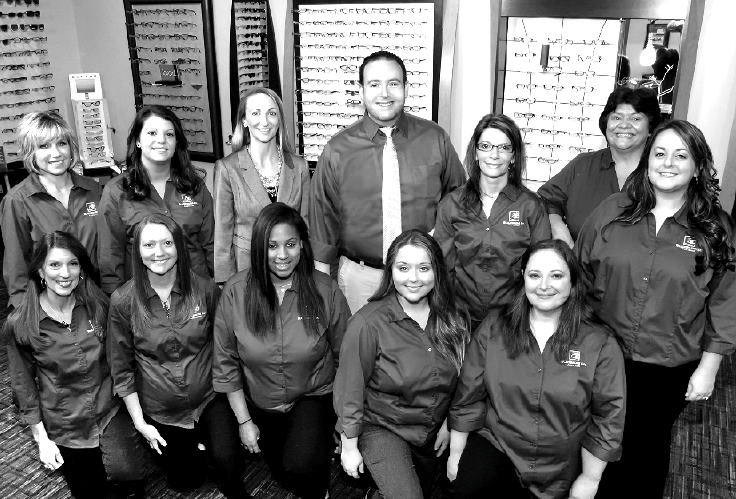
BLACKSBURG EYE ASSOCIATES
Location: Blacksburg, VA / Owner: Dr. John Dovie / Founded: 2008 / Number of employees: 13 /
Specialty: Primary Care / Story by Julie Fanselow
Story by JULIE FANSELOW
As a teenage Boy Scout and the son of a nurse, Dr. John Dovie knew that he wanted to work in public service and science.
Healthcare seemed a natural fit for his ambitions. But Dovie realized in college that eight years of medical school was simply not in the cards. So while he would never be a brain surgeon, that left many allied health professions from which to choose. And Dovie considered them all — from physical therapy to dentistry.
Suddenly, he had a vision. “I came across optometry and it was like a light bulb went off,” Dovie says. To test his hypothesis, Dovie asked to shadow several optometrists as they went through a workday. And finally, he knew what he wanted to do. “I fell in love with it,” he says. The more Dovie investigated the field, the better fit he realized it would be.
Dovie graduated from Virginia Tech, earned his doctor of optometry degree at the Pennsylvania College of Optometry and did a year’s residency at The Eye Institute in Philadelphia. He returned to Virginia and worked three years in private practice. But, all along, he knew he’d eventually open his own business. “I think you learn a lot from a good mentor,” he says, “and learning what you don’t like is as important as learning what you like.” Take overbooking: Dovie hated the idea of stuffing his patient calendar in pursuit of quicker profits. Instead, he aimed to build long-term relationships with people who would come back year after year — and tell their friends.
Although he first had the idea to establish Blacksburg Eye Associates in 2008, Dovie took 18 months to fully launch the business. He kept his job at another private practice and took fill-in work to sock away savings, all while attending to the details of his new venture. Most days, Dovie worked from 6 a.m. to midnight.
Dovie opened the practice in 2009, and it has grown rapidly — from three employees to 12, plus the OD. Human resources are the biggest challenge, from hiring to figuring out benefits and employee reviews to vacations and covering for parents with sick children.
WHAT I’VE LEARNED
- Overbooking = bad.
- Launching a practice is “almost like building a house or having a baby.”
- When patients return for their second annual appointment, you can breathe a sigh of relief. “Once we crested the first year and we started seeing return patients and lots of new patients, too, that’s when I started to feel really comfortable about [the future of the business].”
- Relationships are everything. “Anyone can come, open up a new shop, and sell contact lenses. But building those relationships helps build loyalty, and many of our patients don’t ‘shop around’ to save an extra $10.”
One key principle: as soon as one area of the office appears to be feeling the stress, Dovie will assess staffing, check the budget, and if the numbers are right, make a new hire. To guide such decisions, the practice has a simple rule of thumb: that payroll should be roughly 30 percent of expenses.
Dovie relishes the quality of life and flexibility of being an entrepreneur, from organizing occasional spontaneous staff outings to juggling schedules to give people a three-day weekend. The father of three young children is happy he doesn’t have to miss their soccer games and ballet recitals, yet “when there are days or months when we need extra revenue, I can make the choice to stay late and see a couple of extra patients,” he says. The very best thing? ‘The personal satisfaction of knowing we’re doing things the way they should be done. There are no compromises in quality or ethics or the product we’re delivering.”
Optometrists are in the unique position of providing both healthcare and a related product, he notes. “We’re preventing blindness and curing diseases. A lot of times optometrists get caught up in product and pricing and how patients will respond to things,” he says. “But if you connect with a patient and build a good relationship, that patient will come back and tell their friends about the experience, and that’s how we build our practices.”
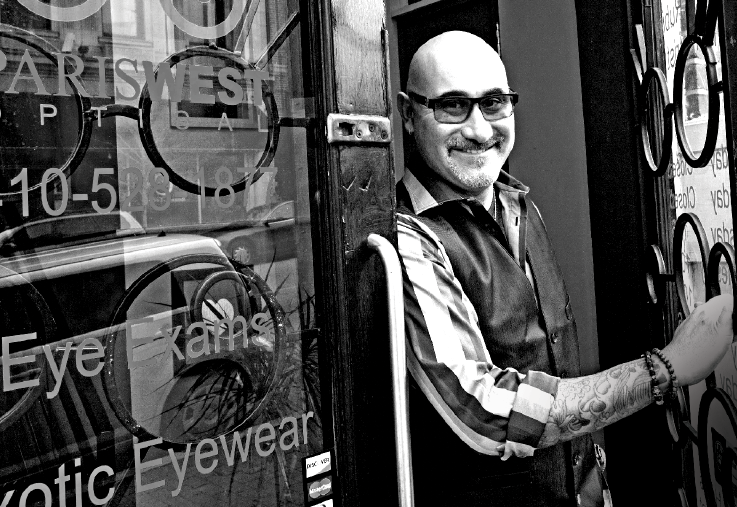
PARIS WEST OPTICAL
Location: Baltimore and Bel Air, MD / Owners: Jordan Flitter (Baltimore), Jordan Flitter, Aubrey Deickman-Hines and Isaac Hines (Bel Air) / Founded: 1994 / Number of employees: 8 (both locations) /
Specialty: Exotic,
Fun and Fine Eyewear / Story by Wendy J. Meyeroff
Cancer changes lives — sometimes more than once in a lifetime.
Jordan Flitter’s own bout with cancer led him to Baltimore, where he launched his successful high-end eyewear business, Paris West Optical. Two decades later, a stranger’s terminal illness led Flitter to expand Paris West at the very time he expected his career to slow down.
“I still wake up in the mornings saying, ‘What have I done?’” Flitter marvels — especially since the new shop’s location an hour from his big-city original isn’t something he could have dreamed up just a year ago.
For the full story, let’s go back to the late 1980s, when the ABO-certified Flitter began his career in Pennsylvania, learning the ropes — and the right way to do things — with an old-school optician. Says Flitter: “One day, he handed me a PD ruler and marker, and said, ‘Do you want to do it right? This doesn’t need batteries. All you have to do is not drink and have a steady hand.’”
In 1993, Flitter learned he had cancer, and he moved to Baltimore in 1994 for treatment at the renowned Johns Hopkins Medical Center. When his cancer went into remission, he had the chance to resurrect an upscale optical shop in the city’s Mount Vernon neighborhood.
Flitter maxed out his credit cards to lease the 1,000-foot space. Plastic paid for “everything: security deposit, inventory, fixtures, equipment, advertising … even my first month’s rent.” His mother told him he had a lot of chutzpah — not to mention “other words I can’t repeat,” he says. But the investment paid off as Flitter built a thriving boutique that now carries 7,000 designs.
After years of 80-hour weeks, Flitter was ready to scale back. Then he got a call in March 2013 from an optometrist he had never met. Bruce Linder had a surprising offer: He wanted Flitter to take over his business of 37 years.
WHAT I’VE LEARNED
- Merge with care. Paris West’s acquisition of Linder Optical made sense, in part, because the businesses “had pretty much the exact same beliefs on how an optical shop should be run.”
- Have some chutzpah.
- Before Bruce Linder died in August 2013, he and his family prepared current customers for the transition to Paris West, assuring them it was what he wanted. “He emphasized that it was a succession and not a corporate takeover.”
- connections matter.
At community events, staff of
Paris West’s new store hand out cards saying “Hi, we’ve taken over Linder Opticians. Come in and see us.”
“Bruce knew me and my business from reputation. We’ve won ‘Best Optical Shop in Baltimore’ many times,” Flitter says. “Initially, I turned him down, but when he admitted he had cancer, as a two-time cancer survivor, I figured I could at least meet him for lunch.”
That lunch marked the first step of another new journey. “I was impressed by the longevity of his shop and that his passion for it had continued unabated for close to four decades,” Flitter wrote on his blog.
Even with so much in common, Flitter wasn’t convinced. “Bel Air is an hour away from my house and current store,” he says. But he had friends there: Aubrey Deickman-Hines, Isaac Hines and their three children, including Flitter’s goddaughter. They said they’d put up half the money, and Aubrey, who had worked in the Baltimore store, said she’d help out in Bel Air.
That made Flitter confident his customers would be in good hands. “I taught her to do adjustments, interpret prescriptions, troubleshoot them, take base curves, align pantoscopic tilts, adjust glasses properly,” he says. “And I mean properly. If you can’t adjust glasses correctly, I don’t want you touching my customers’ $700 frames.”
Paris West’s Baltimore location features bold decor and a fun vibe, while the Bel Air shop hadn’t been updated in many years. “So we’ve been changing things slowly,” says Flitter, emphasizing the logo and colors that people associate with Paris West. “We want to be identifiable.”
Flitter admits a slower transition would have been welcome. “But cancer doesn’t wait,” he says. Now, Bel Air customers who’d been traveling to Baltimore are happy to have a Paris West presence much closer to home. And Flitter has seen yet again that sometimes, life is what happens to you when you’re busy making other plans.
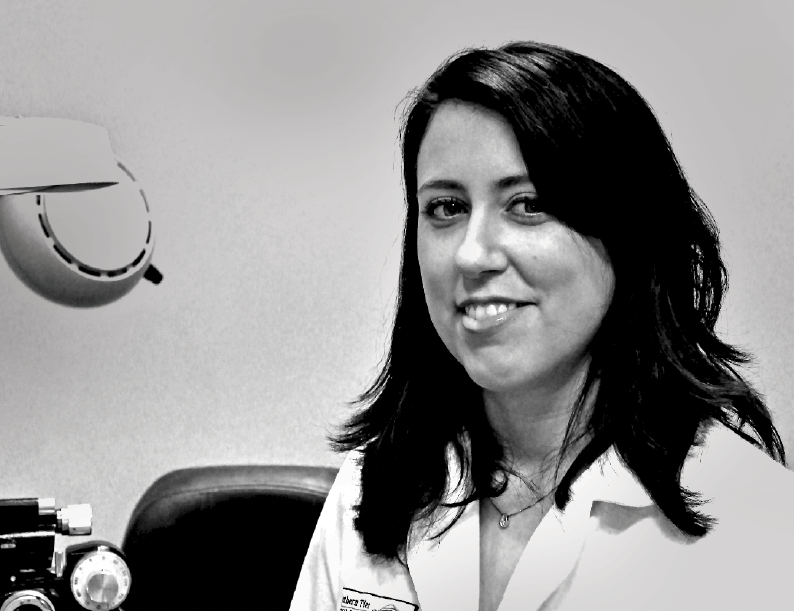
SOUTHERN TIER OPTOMETRY
Location: Jamestown, NY / Owner: Dr. Kara Gibbs / Founded: 2012 / Number of employees: 4 /
Specialty: Children’s Eyecare / Story by Julie Fanselow
The future Dr. Kara Gibbs was introduced to optometry at age 12. It was not the friendliest of introductions.
The image-conscious near-teenager met her optometrist and received crushing news. She needed — gasp! — glasses. Says Gibbs: “I didn’t think anything was wrong with my eyes and I was really kind of bummed out that I needed to wear glasses. But I put them on and it was like ‘Oh my gosh. You’re supposed to be able to see like this?’”
Gibbs points to the experience as a first spark of interest in what would become her career.
A good student throughout school, Gibbs began college thinking she’d possibly become a science teacher. But another trip to the optometrist changed her course. “During one of my Christmas breaks from college I was home and getting my annual eye exam, and it hit me in a different light,” she says. From St. Francis University, she went to the Ohio State University College of Optometry and worked in several practices back in upstate New York before opening Southern Tier Optometry in February 2012.
In fall 2011, she heard a continuing education presentation from a man who had started his own eyecare business. Inspired, Gibbs thought, why not me?
From that point, it took Gibbs just six months to get Southern Tier’s doors open, though she had a good reason for the haste: She wanted to be in business before the month of March, which is traditionally the busiest time for eyecare and eyewear professionals in upstate New York for two reasons. People get their income tax refunds, so they have money to spend — and there’s also a pent-up demand from folks who have been cooped up during the region’s harsh winters.
WHAT I’VE LEARNED
- Ask: Why not me?
- Select a specialty, then work it. Gibbs handles
other types of patients, but her goal is to build
a strong children’s business.
- Go ahead
and launch.
“I don’t think there’s a perfect time or perfect place and you’ll never have enough money at first.”
- Tailor your marketing. Country music radio stations have proven a good fit for Southern Tier to advertise its family-friendly services.
With her hurry-up timetable in place, Gibbs had plenty to do, from finding financing and the right location to ordering equipment, building a website, working with insurance companies and hiring staff. At first, her only employee was her sister-in-law, who is pursuing her New York optician’s license while working as an apprentice optician. But early growth has been robust enough that Southern Tier has expanded staff to include a patient coordinator and optometric technician.
Gibbs’ ultimate mission is to establish a strong niche in children’s eyecare. And she is both savvy and ambitious about building her children’s business. She networks with local pediatricians who give her referrals. No one leaves Southern Tier without being asked whether their children and grandchildren have had their eyes examined, and the staff often make those appointments before the patient is out the door.
These outreach efforts help Gibbs build her business while letting customers know the importance of eye exams for children well before they learn to read. Starting eye exams as early as six months of age helps ensure that kids are ready to learn, but Gibbs also promotes back-to-school checkups for school readiness.
Gibbs — who has a daughter, Lauren, and a son, Logan — says starting her own practice has both simplified and complicated her family life. Her husband, Tom, is a physical therapist with many home-care visits, so he’s usually able to be home when the kids are done with school. Tom is the go-to guy for getting dinner on the table and doing laundry, too. “But if there’s something I need to be home for, I can,” says Gibbs. “I have that flexibility.”